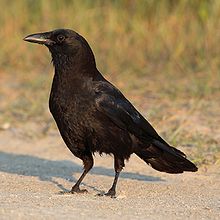
Back Kraai AF ቁራ AM Ak’ak AMI Corvus AN Crāwe ANG غراب (جنس) Arabic غراب (جنس من الطيور) ARZ কাউৰী AS Corvus AST Qarğa AZ
| Corvus | |
|---|---|

| |
| American crow (Corvus brachyrhynchos) | |
| Scientific classification | |
| Domain: | Eukaryota |
| Kingdom: | Animalia |
| Phylum: | Chordata |
| Class: | Aves |
| Order: | Passeriformes |
| Family: | Corvidae |
| Subfamily: | Corvinae |
| Genus: | Corvus Linnaeus, 1758 |
| Type species | |
| Corvus corax Linnaeus, 1758
| |
| Species | |
|
Many, see List of Corvus species | |
| Diversity | |
| 50 species[2] | |
Corvus is a widely distributed genus of passerine birds ranging from medium-sized to large-sized in the family Corvidae. It includes species commonly known as crows, ravens, and rooks. The species commonly encountered in Europe are the carrion crow, hooded crow, common raven, and rook; those discovered later were named "crow" or "raven" chiefly on the basis of their size, crows generally being smaller. The genus name is Latin for "raven".[3]
The 46 or so members of this genus occur on all temperate continents except South America, and several islands. The Corvus genus makes up a third of the species in the family Corvidae. The members appear to have evolved in Asia from the corvid stock, which had evolved in Australia. The collective name for a group of crows is a "flock" or a "murder".[4]
Recent research has found some crow species capable of not only tool use, but also tool construction.[5] Crows are now considered to be among the world's most intelligent animals[6] with an encephalization quotient equal to that of many non-human primates.[7]
- ^ Cite error: The named reference
radiationwas invoked but never defined (see the help page). - ^ Gill, Frank; Donsker, David; Rasmussen, Pamela, eds. (August 2024). "Crows, mudnesters, birds-of-paradise". IOC World Bird List Version 14.2. International Ornithologists' Union. Retrieved 16 September 2024.
- ^ Jobling, James A (2010). The Helm Dictionary of Scientific Bird Names. London: Christopher Helm. p. 119. ISBN 978-1-4081-2501-4.
- ^ "Murder of Crows, etc". Word-detective.com. Archived from the original on 2 June 2012. Retrieved 29 June 2023.
- ^ Winkler, Robert (8 August 2002). "Crow Makes Wire Hook to Get Food". National Geographic. Archived from the original on 15 February 2006. Retrieved 6 February 2011.
- ^ "A Murder of Crows". Nature. PBS video. 24 October 2010. Retrieved 6 February 2011.
New research indicates that crows are among the brightest animals in the world.
- ^ "Crows as Clever as Great Apes, Study Says". National Geographic News. NG Society. 9 December 2004. Archived from the original on 12 December 2004. Retrieved 24 June 2015.
Emery and Clayton write, "These studies have found that some corvids are not only superior in intelligence to birds of other avian species (perhaps with the exception of some parrots), but also rival many nonhuman primates."